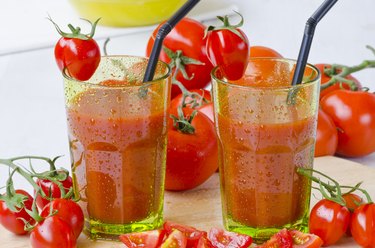
Most Americans meet just a little more than half of their daily vegetable needs, according to the USDA. Increasing your intake of vegetables offers a number of health benefits, including lowering your risk of heart disease, some cancers and diabetes. You may prefer drinking your vegetables to eating them. Both V8 Vegetable Juice and tomato juice are low in calories and nutrient-rich, offering different amounts of certain nutrients.
Calories
Video of the Day
While both V8 and tomato juices are low-calorie choices, tomato juice is slightly lower in calories than V8 juice. A 1-cup serving of tomato juice contains 41 calories, while the same size serving of V8 juice contains 51 calories.
Video of the Day
Carbohydrates, Protein and Fat
Carbohydrate, protein and fat content of both juices are very similar, although the tomato juice contains a small amount of fat and the V8 juice is slightly higher in fiber. A 1-cup serving of V8 juice contains 10 g of carbohydrates, 1.9 g of fiber, 2 g of protein and 0 g of fat, while a 1-cup serving of tomato juice contains 10 g of carbohydrates, 1 g of fiber, 1.8 g of protein and 0.1 g of fat. The fiber in the vegetable juices can aid in hunger control and improve bowel movements.
Sodium
Both the V8 and tomato juice are high in sodium. A 1-cup serving of the V8 juice contains 420 mg, and the same size serving of tomato juice contains 654 mg. Consuming too many high sodium foods can cause your body to retain fluids and raise blood pressure. You should limit your daily intake to less than 2,300 mg a day. To help limit your intake, you may consider choosing low-sodium versions of both the V8 and tomato juice, contain 141 mg and 24 mg of sodium per serving, respectively.
Vitamins and Minerals
Both the V8 and tomato juice are good sources of vitamins A and C, potassium and iron. The V8 juice is a better source of vitamins A and C, while the tomato juice is a better source of potassium and iron. A 1-cup serving of V8 juice contains 72 mg of vitamin C, 2,000 IU of vitamin A, 0.73 mg of iron and 469 mg of potassium. A 1-cup serving of tomato juice contains 45 mg of vitamin C, 1,094 IU of vitamin A, 1.04 mg of iron and 556 mg of potassium.
- USDA: Nutrient Database
- U.S. Department of Agriculture: Dietary Guidelines for Americans, 2010: Foods and Food Components to Reduce
- U.S. Department of Agriculture: Dietary Guidelines for Americans, 2010: Building Healthy Eating Patterns
- MayoClinic.com; Dietary Fiber: Essential for a Healthy Diet; November 2009